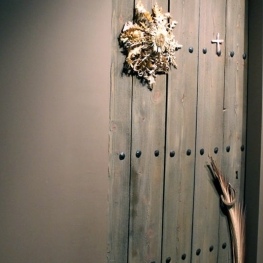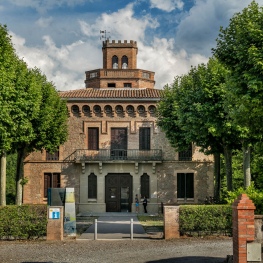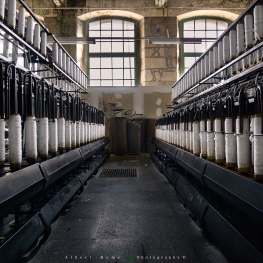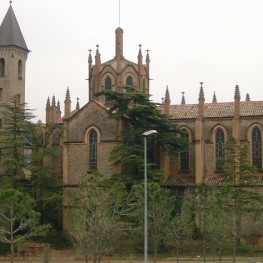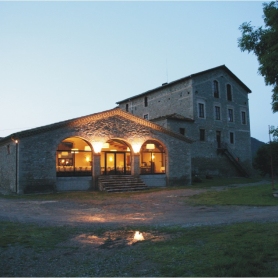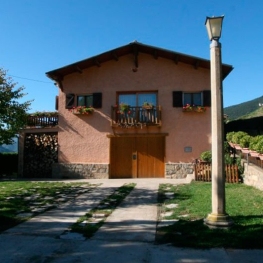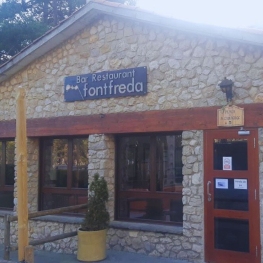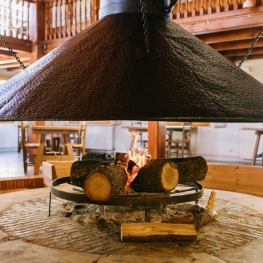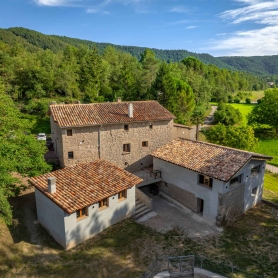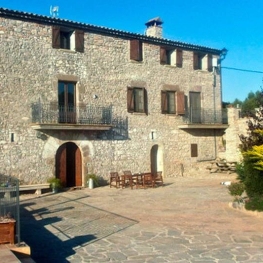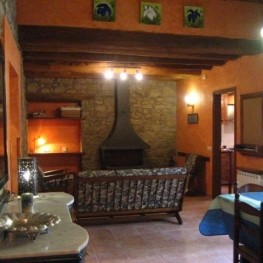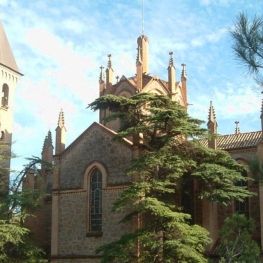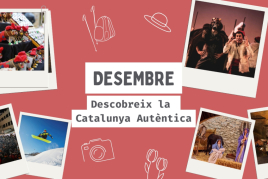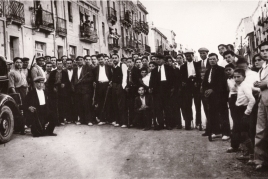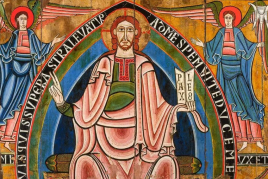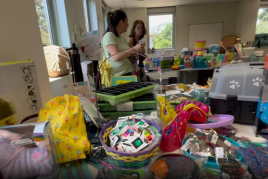A walk through the history of Sant Feliu Sasserra
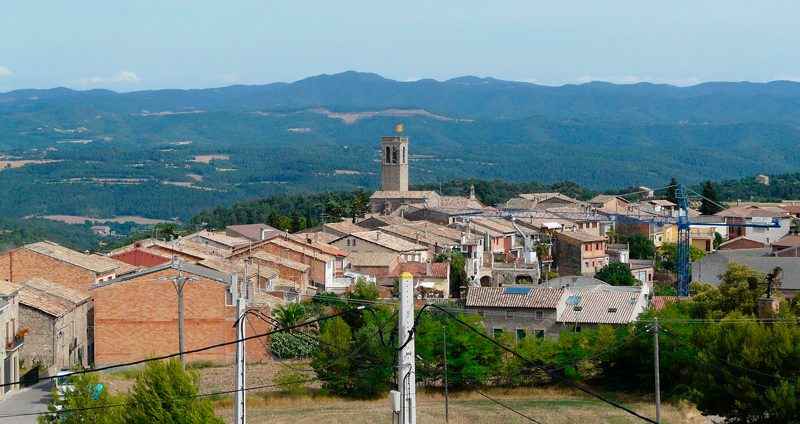
The town of Sant Feliu Sasserra is full of places full of history. A story that is still preserved today and that we can enjoy through an itinerary of 30 points of interest where we will find a small lectern that identifies, and that includes a QR code, which will allow us to obtain more information about each place.
Here are some of the most relevant points of this itinerary.
A village dominated by castles
 The town was born around the church of Sant Feliu, which has the first news at the end of the 10th century. Little by little, the houses were distributed around the royal road that went from Barcelona to France, also known as the road from Manresa to Ripoll, giving rise to the current configuration of the town.
The town was born around the church of Sant Feliu, which has the first news at the end of the 10th century. Little by little, the houses were distributed around the royal road that went from Barcelona to France, also known as the road from Manresa to Ripoll, giving rise to the current configuration of the town.
Until the eleventh century Sant Feliu depended on the castle of Oristà and, thereafter, became dependent on the castles of Tornamira and Lluçà. According to J. Torres, J. Planas and J. Serra, the Relat stream served as a border between the domains of the Tornamira, on the left, where the town is located today, and those of the Lluçà, on the right.
Main Street
The primitive nucleus of the town formed around the church of Sant Feliu, documented as early as 946. This was growing little by little, but in the second half of the 16th century, thanks to the expansion of the traditional textile industry and commerce, the Villa of Sant Feliu Sasserra enjoyed a considerable population increase.
 This fact is demonstrated with the relations of fires made in the years 1553 and 1595 where it passes from 57 to 105 fires. At the beginning of the 17th century, Sant Feliu was the main town of Lluçanès and the only one in the area with a city title, which allowed it to become the capital of the Lluçanès subveguería.
This fact is demonstrated with the relations of fires made in the years 1553 and 1595 where it passes from 57 to 105 fires. At the beginning of the 17th century, Sant Feliu was the main town of Lluçanès and the only one in the area with a city title, which allowed it to become the capital of the Lluçanès subveguería.
At this time, here in the main street was the main urban center. During the 17th century, the nucleus continued to grow with surrounding houses. At the end of the century, in 1686, the ecclesiastical census attributed to Sant Feliu Sasserra 118 houses together and 12 farmhouses, which represented a population close to 700 inhabitants. At the beginning of the 18th century and in the framework of the War of Succession, the town was burned by the Filipino troops.
However, the city recovered economically thanks to wool textile manufacturing. This sector continued to progress until the second half of the nineteenth century, when the arrival of mechanization caused artisanal production to decline. Parallel to the evolution of the textile sector, the rural area of the municipality experienced a period of splendor as a result of the production and marketing of wine, especially during the seventeenth, eighteenth and nineteenth centuries until the arrival of the phylloxera thread. This is demonstrated by the terraces and tubs of most farmhouses and houses in the municipality.
Hermitage of Santa Magdalena
 The hermitage of Santa Magdalena is a single-nave building decorated with a series of columns and plaster cornices. The roof is crowned by a belfry bell tower from later times. On the lintel of the facade is the date of 1762 inscribed inside a stamp. Crowning the door is a pediment with a Latin cross in the center. Above the main door opens a circular porthole.
The hermitage of Santa Magdalena is a single-nave building decorated with a series of columns and plaster cornices. The roof is crowned by a belfry bell tower from later times. On the lintel of the facade is the date of 1762 inscribed inside a stamp. Crowning the door is a pediment with a Latin cross in the center. Above the main door opens a circular porthole.
The name is given by the existence of the chapel of Santa Magdalena, documented since 1288, although the current building does not retain any remnants of medieval times. The building currently preserved is neoclassical and was built under the new invocation of San Salvador de Horta in 1762, as shown by the lintel date.
La Farinera
 The Farinera (flour) is formed by two terraced bodies of different height, with double slope roofs and waters in the main facade. The load walls are made of stone masonry, worked on the facade, and mortar, with reforms and extensions made with brick and cement.
The Farinera (flour) is formed by two terraced bodies of different height, with double slope roofs and waters in the main facade. The load walls are made of stone masonry, worked on the facade, and mortar, with reforms and extensions made with brick and cement.
One of the most outstanding elements of the building is the service door, located on the opposite side of the main door, in the square below. It is accessed from a scale of four stone steps per side, reinforced by two small buttresses. Its elevated situation was made expressly, to be at the same level of the cars that loaded the flour. The farinera gave grinding service in the village for a long time.
Parish Church Portal
The Romanesque doorway of the parish church is a half-pointed arch portal with two degrading archivolts that rest on an impost that extends, under the arches, from one end to the other of the cover. The impost at the same time makes abacus of the couple of capitals of relief that are in each part, which are supported by columns.
 The internal archivolt is ornamented with interwoven wicker, while the external one is adorned with leaves that are arranged between knotted ribbons. The two inner capitals are sculpted with historical scenes with representations of two sets of characters, richly worked on clothing, shapes and details. Unfortunately, they have been badly mistreated and present serious mutilations to the point that they hinder the interpretation of the scenes represented. Probably, the right inner capital contains a representation of the Domini Maiestas flanked by two turiferary angels (who hold censers). As for the left inner capital, its poor state of preservation does not allow a careful reading of the representation it contains.
The internal archivolt is ornamented with interwoven wicker, while the external one is adorned with leaves that are arranged between knotted ribbons. The two inner capitals are sculpted with historical scenes with representations of two sets of characters, richly worked on clothing, shapes and details. Unfortunately, they have been badly mistreated and present serious mutilations to the point that they hinder the interpretation of the scenes represented. Probably, the right inner capital contains a representation of the Domini Maiestas flanked by two turiferary angels (who hold censers). As for the left inner capital, its poor state of preservation does not allow a careful reading of the representation it contains.
As for the two outer capitals, they are decorated with plant and animal elements. Thus, the left outer capital has three eagles represented standing, in a frontal position, the swollen chest, looking sideways, with the wings extended and with the claws catching the collar. It is a type of representation quite common in the framework of Romanesque in Catalan counties, as is the type of plant ornamentation distributed in two overlapping floors that contains the right outer capital. Each floor has a different type of leaves, all full of nerves.
The Communor and the cemetery
They are constructions that have their origin in very remote times and are closely linked to one of the concerns that most affect and have affected people throughout history: the fear of meteorological changes. In a deeply Christian and eminently agricultural society, when a terrible danger appeared coming down from heaven, it was necessary to implore heaven.
 It is a type of construction that used to be part of the body of the church or was built in an exempt manner, but little separated from it. They were usually shaped like turrets or cutlery and always had openings at four winds. They served as shelter to celebrate the exorcism rituals of the storms when lightning, hailstorms or inopportune showers could endanger the crops.
It is a type of construction that used to be part of the body of the church or was built in an exempt manner, but little separated from it. They were usually shaped like turrets or cutlery and always had openings at four winds. They served as shelter to celebrate the exorcism rituals of the storms when lightning, hailstorms or inopportune showers could endanger the crops.
The word commoner means to conjure bad weather with prayers or exorcisms. It is for this reason that these types of constructions are called a comunador or conjuradores, but also reliquers, since during the exorcism it was necessary to be accompanied by relics of Vera Cruz, or also of some of the holy lawyers against bad weather and protectors of the peasantry, such as Santa Barbara, San Marcos or San Abdón and San Senén, for example.
 The specific liturgy associated with these spaces was complex and could vary according to the bishoprics or parishes, but normally it worked like this: if the situation began to be threatening, a bell chime began and, in spite of this, the storm did not fade or increased, the priest dressed solemnly and immediately began to perform the ceremonial communion with the prayers and formulas of exorcism and sprinkling of the holy water through the four openings. The texts used to be emphatic, characterized by a strongly vibrant and energetic tone, since at that time the population, mostly peasant, could only resort to divine help as a last and last resort to save the crops.
The specific liturgy associated with these spaces was complex and could vary according to the bishoprics or parishes, but normally it worked like this: if the situation began to be threatening, a bell chime began and, in spite of this, the storm did not fade or increased, the priest dressed solemnly and immediately began to perform the ceremonial communion with the prayers and formulas of exorcism and sprinkling of the holy water through the four openings. The texts used to be emphatic, characterized by a strongly vibrant and energetic tone, since at that time the population, mostly peasant, could only resort to divine help as a last and last resort to save the crops.
It was so important to exorcise the storms that in many dioceses priests were forbidden to leave the parish from the feast of the Invention of the Holy Cross - on May 3 - until the day of the Exaltation of the Holy Cross - the September 14-, to a greater abundance to conjure the bad weather from spring to harvest, when the harvests - a vital and fundamental good for the people - could be lost. In some sea towns, bad weather was also conjured when fishing could be prevented or hindered.
As a curious note, 1629 in the church cemetery grazed herds and the visitor, in realizing, threatened with excommunication, proclaiming that "no one dares to make or contribute any filth within the Circus of the sementiri of said church and Atte that the lloch be sacred and dedicated for the funeral of the deceased faithful. "
The cemeteries
Although at least since the ninth century there are already frequently hermitages and churches surrounded by burials, and although it may seem strange, even in the middle of the Middle Ages the burial of the family dead in the parish cemeteries had not become widespread.
It was for this reason that the creation of sagreres, around the churches, was founded so that the dead could rest on sacred ground and that their rest would not be disturbed. Uprooting the custom of burying the dead inside the houses or in the immediate vicinity, which was already being done in the nuclei of the indigenous population during the times of the Roman conquest, must have proved difficult for ecclesiastical and civil authorities.
The itinerary through Sant Feliu Sasserra
 As we have already mentioned, the itinerary consists of 30 points of interest identified with a QR code. To get more information about each of them, you need to have a QR code reading program installed on your smartphone or tablet.
As we have already mentioned, the itinerary consists of 30 points of interest identified with a QR code. To get more information about each of them, you need to have a QR code reading program installed on your smartphone or tablet.
Once the QR code reader program is open, you will only have to bring the camera closer to the QR code and a page will open automatically with the information corresponding to the point of interest where you are.
The points of interest that make up the itinerary are:
- Former sub-department
- Plaza Mayor Hostel
- Main Street
- House and joys of San Pedro Almató
- Fountain of the Corda
- Hermitage of Santa Magdalena
- Vilaclara street
- Ca l'Arola
- Serrat de les Forques
- Hiparc Circle
- Vilaclara roundabout
- Pedró de San Roque
- Vineyard Barrack of the Aurora Plain
- Cal Boixeres
- Vilaclara Tower
- Paso Nuevo Street
- La Farinera
- Interpretation Center of Witchcraft
- Parish Church
- Parish Church Portal
- The Communor and the cemetery
- Balmes Street
- Can Vall
- Fonda Chapel
- There puig
- Acts of 1714 in Sant Feliu Sasserra
- Witches Fair
- Legends of Sant Feliu Sasserra
- The Carlist Wars
- Medieval Castle of Sa Cirera
You can find all the information on this points here.
What to do
Centre d’Interpretació de la Bruixeria
Sant Feliu SasserraThe Bruixeria de Sant Feliu Sasserra Interpretation Center invites visitors to get…
La Torre de l'amo de Viladomiu Nou
Gironella (a 13 Km)Transported back in time and enjoy a building protected as a cultural…
Museu de la colònia Vidal de Puig-Reig
Puig-reig (a 11.8 Km)A visit to the Colonia Vidal de Puig-reig allows us to understand…
Centre d'interpretació de l'Església de Cal Pons
Puig-reig (a 12.3 Km)The Interpretation Center of the Colonia Pons Church, through three museum spaces,…
Where to eat
Restaurant Dachs
Les Llosses (a 24.1 Km)Restaurant Dachs offers versatile spaces for celebrations in Les Llosses, with rustic…
Restaurant Font Freda
Castellar del Riu (a 26 Km)A restaurant offering a wide selection of Catalan dishes, especially notable for…
Restaurant Apartaments Els Roures
Castellar del Riu (a 26.2 Km)Rest, charm and good cuisine, a unique space located in Berguedà, at…
Where to sleep
Cal Fargas Turisme Rural
Santa Maria de Merlès (a 6.7 Km)At Cal Fargas, comfortable rooms await you in a house surrounded by…
Sellarés Rural
Sallent (a 14.5 Km)Cal Sellarés is a farmhouse documented since the 14th century, located in…
Can Masover Xic
Lluçà (a 14.1 Km)Can Masover Xic is a rural house located in the Rocadenbosch farmhouse…
Alberg Cal Pons, Fundesplai
Puig-reig (a 11.6 Km)Discover Cal Pons, a hostel that is part of the architectural complex…


